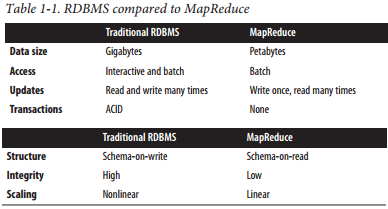REF :- HADOOP : THE DEFINITIVE GUIDE :- BY TOM WHITE ( THE BIBLE OF HADOOP ) [ Relational Database Management Systems Why can’t we use databases with lots of disks to do large-scale analysis? Why is Hadoop needed? The answer to these questions comes from another trend in disk drives: seek time is improving more slowly than transfer rate. Seeking is the process of moving the disk’s head to a particular place on the disk to read or write data. It characterizes the latency of a disk operation, whereas the transfer rate corresponds to a disk’s bandwidth. If the data access pattern is dominated by seeks, it will take longer to read or write large portions of the dataset than streaming through it, which operates at the transfer rate. On the other hand, for updating a small proportion of records in a database, a traditional B-Tree (the data structure used in relational databases, which is limited by the rate at which it can perform seeks) works well. For updating the majority of a datab
